So if you’re thinking about a kitchen renovation, I cannot recommend microcement enough. It looks so clean and so modern, it makes everything look like one continuous surface and can completely change a space.
If you’re wondering why so many people have jumped on the microcement bandwagon when it comes to kitchens, it’s because the material is super durable, low-maintenance and works with any aesthetic you want to create.
I cover its benefits, types and designs, and give you practical ideas to apply in your home. Your dream kitchen may be closer than you think!
What Is a Microcement Kitchen?
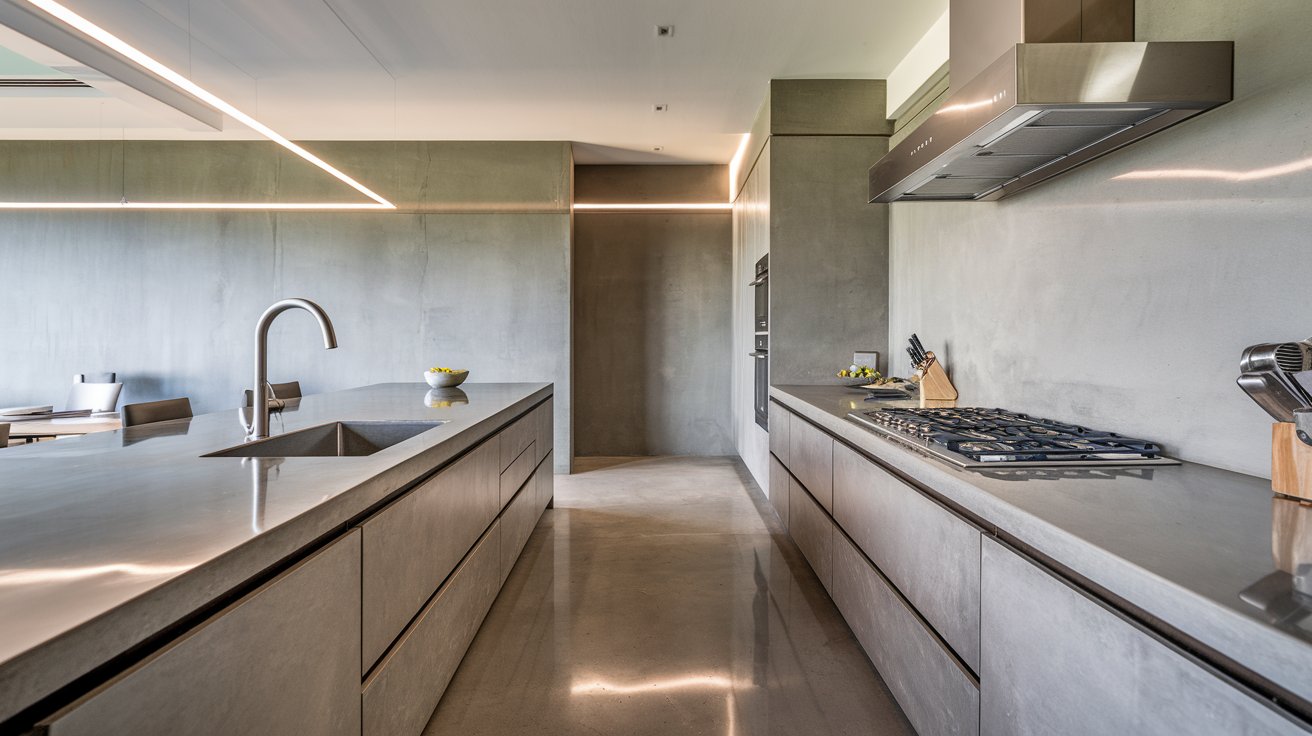
Microcement is a thin coating made from cement, polymers, and resins. You apply it in layers over your existing surfaces.
How is it different? Tiles have grout lines. Microcement doesn’t. Marble stains easily. Microcement resists stains. It’s also thinner and lighter than quartz.
Why does this work so well in kitchens? It handles water, scratches, and heat. You can use it on floors, walls, and countertops. No seams means less cleaning hassle.
The result? A smooth, modern look that fits any space.
Why Choose Microcement for Your Kitchen?
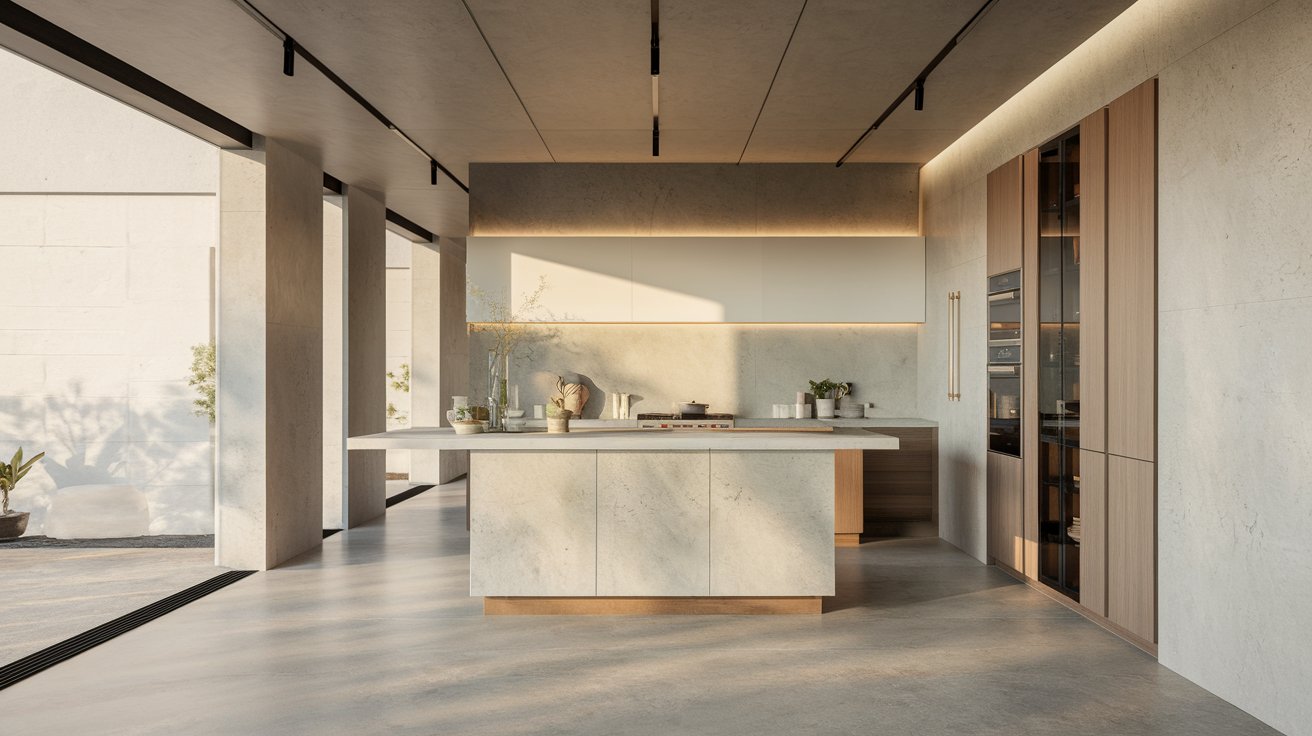
Let me walk you through the reasons why microcement makes sense for your kitchen. From its practical benefits to design flexibility, this material offers solutions that traditional options can’t match.
1. Seamless and Modern Finish
You won’t see any joints or grout lines with microcement. It creates one continuous surface across your entire kitchen.
This clean look works perfectly if you prefer minimalist or contemporary styles. The smooth finish gives your space a polished, professional appearance that’s hard to achieve with tiles or other materials.
2. High Durability and Resistance
Your kitchen faces spills, heat, and constant use. Microcement handles all of it. It resists stains, moisture, and scratches better than many traditional materials.
High-traffic areas and humid spots near the sink won’t be a problem. This toughness means your surfaces stay looking good for years.
3. Easy Maintenance
Cleaning becomes much simpler without grout lines to scrub. The smooth, continuous surface stops dirt from hiding in cracks and crevices.
Just wipe down with mild soap and water. That’s it. You’ll spend less time maintaining your kitchen and more time enjoying it. No special cleaners or tools needed.
4. Quick Installation Without Demolition
Here’s the best part. You don’t need to rip out your existing tiles or countertops. Microcement applies directly over what you already have.
This approach saves you significant time and money on your renovation project. Less mess, less disruption, and faster results. Your kitchen upgrade becomes much more manageable.
5. Eco-Friendly and Sustainable
You’re making a responsible choice by keeping your current surfaces instead of sending them to a landfill. This reduces waste considerably.
Microcement also lasts for many years, which means fewer replacements over time. It’s a smart option if you care about reducing your environmental impact while improving your home.
6. Customizable Colors and Finishes
Pick from a wide range of colors, from soft neutrals to bold contemporary shades.
You can also choose your finish type: matte for a subtle look, satin for moderate shine, or glossy for maximum reflection.
This flexibility means microcement adapts to your personal style, not the other way around.
Microcement Kitchen Applications
You can apply microcement to almost any surface in your kitchen. Let’s look at where it works best and how it can change different areas of your space.
1. Microcement Kitchen Floors

Your kitchen floor needs to handle foot traffic, spills, and dropped items. Microcement delivers on all fronts. It provides a durable, slip-resistant surface that holds up to daily use.
If you have underfloor heating or plan to install it, microcement works perfectly with these systems. The material conducts heat well, keeping your feet warm during cold months.
2. Microcement Kitchen Walls and Backsplash

Forget scrubbing grout lines behind your stove. Microcement creates a waterproof barrier that’s simple to wipe clean. It offers a modern alternative to traditional tiles.
You can add texture or keep it smooth, depending on your preference. The continuous surface behind your cooking area looks sleek and handles splashes without any fuss or damage.
3. Microcement Kitchen Countertops
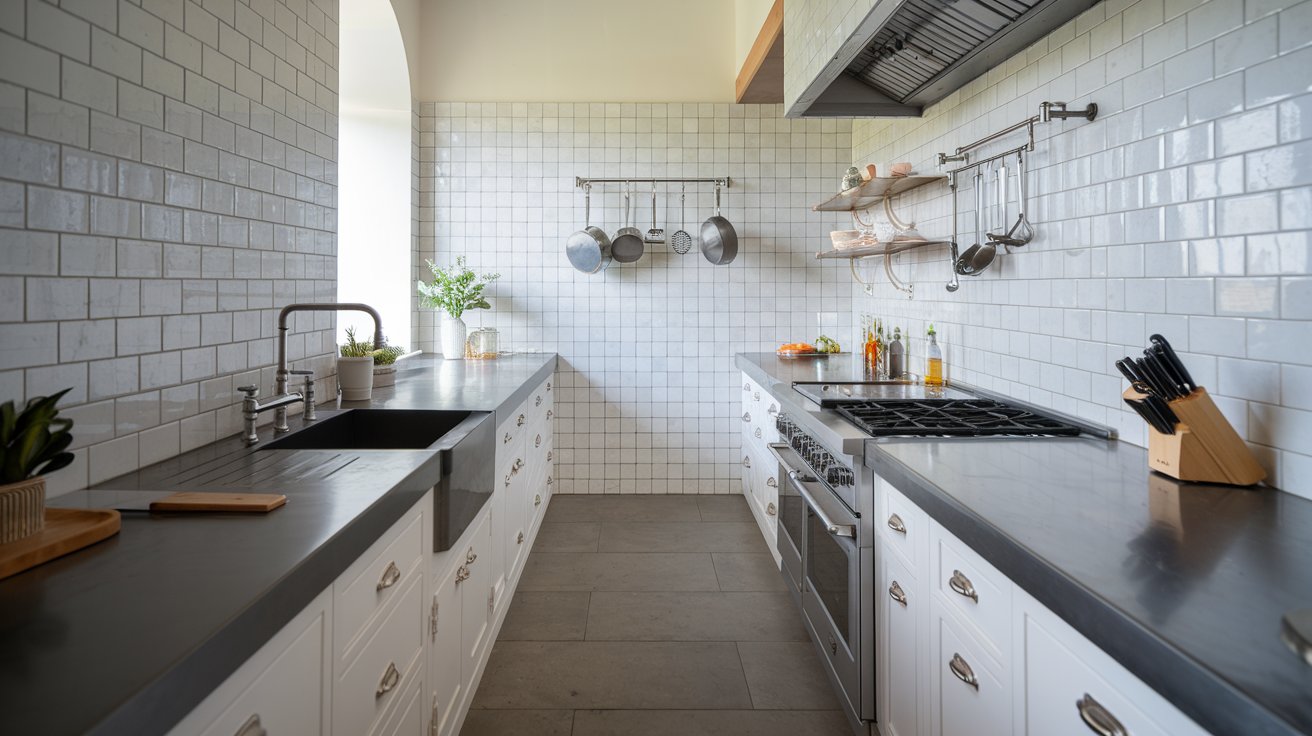
Your countertops get the most action in the kitchen. Microcement creates a smooth, continuous work surface without visible seams. It resists heat from hot pots and pans when properly sealed.
Stains won’t penetrate the surface if you maintain the protective coating. You get a contemporary look that’s also highly functional for meal prep and cooking tasks.
4. Microcement Kitchen Islands
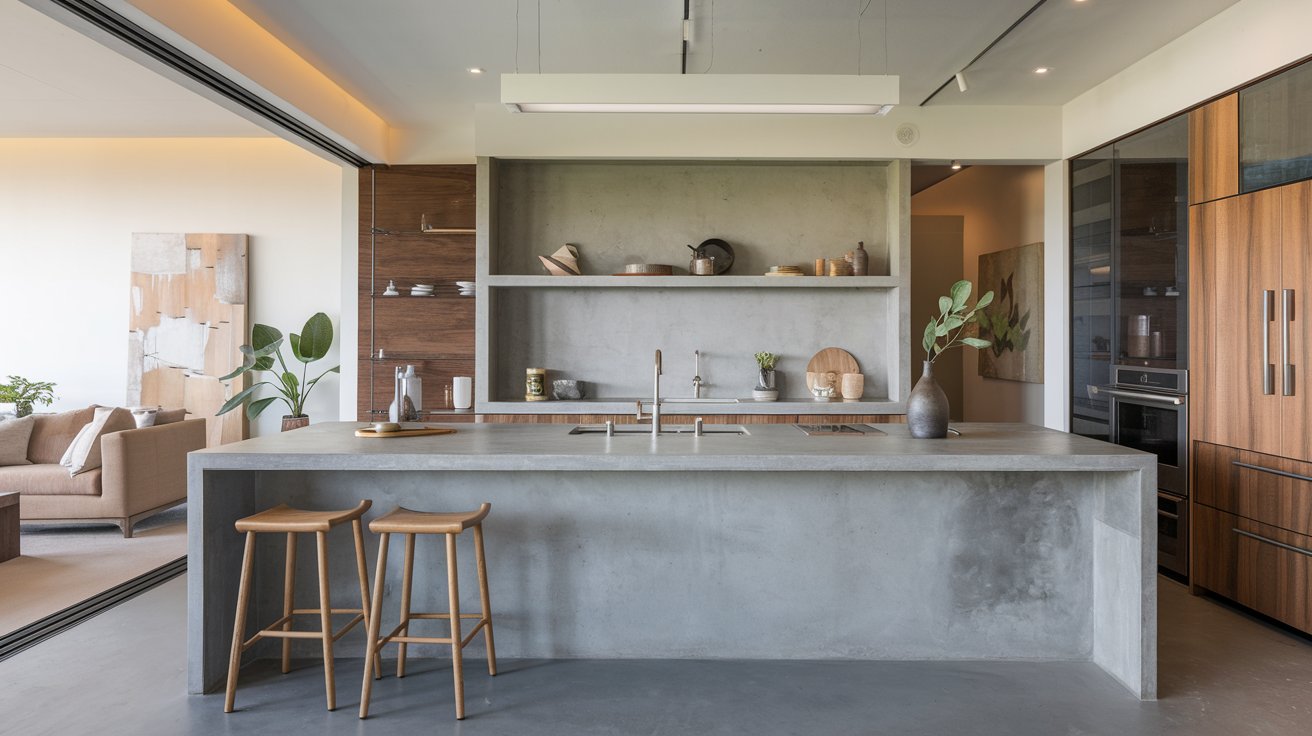
A kitchen island often becomes the heart of your home. Microcement turns it into a real focal point. The seamless finish works beautifully in open floor plans where the kitchen connects to living spaces.
You combine good looks with practical benefits. The surface handles everything from food prep to casual dining while looking impressive.
5. Microcement Kitchen Cabinets

Want a cohesive look throughout your kitchen? Apply microcement to your cabinet fronts. This creates visual harmony when you match it with your countertops or floors.
The uniform finish suits modern and minimalist designs perfectly. Your cabinets become part of a complete design story rather than separate elements competing for attention.
Microcement Kitchen Colors and Finishes
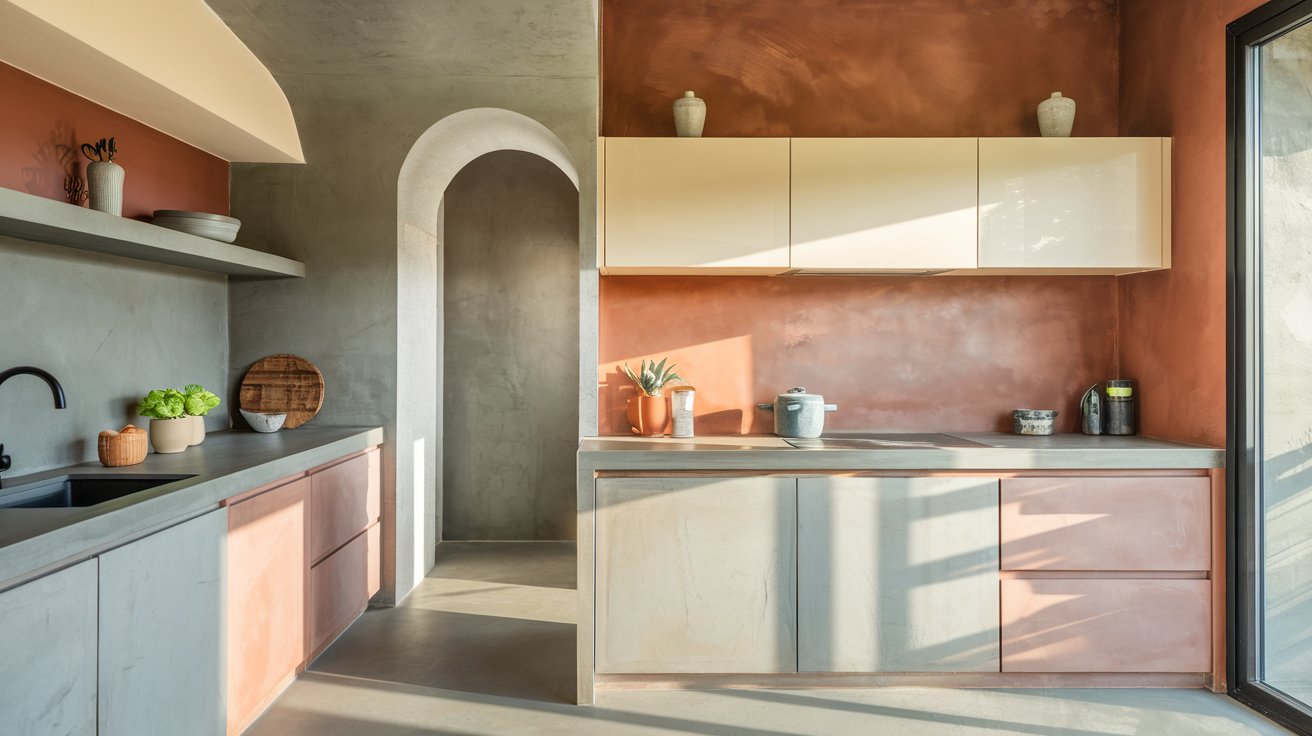
Choosing the right color and finish makes a big difference in your kitchen. Let me break down your options.
Warm neutrals like beige and cream are popular right now. Greys work with almost any style. Whites keep things bright and airy. Earth tones like terracotta add natural warmth.
You have three finish options. Matte hides fingerprints and looks subtle. Satin gives a soft shine. Gloss reflects light and makes colors stand out, but shows smudges more.
How do you pick the right color? Look at your natural light. Dark colors need lots of windows. Light colors help brighten dim spaces. For open kitchens, choose colors that match nearby rooms. Smaller kitchens look bigger with lighter shades.
How to Maintain a Microcement Kitchen
Taking care of your microcement surfaces is straightforward. Follow these simple tips to keep everything looking fresh.
- Use gentle, pH-neutral cleaners for daily cleaning. Avoid harsh chemicals like bleach or ammonia that can damage the protective sealant.
- Wipe up spills immediately, especially acidic liquids like lemon juice or wine. Quick action prevents stains from setting into the surface.
- Reapply sealant every 1-2 years to maintain long-term protection. Check with your installer about the best schedule for your kitchen.
- Always use mats or trivets under hot pots and pans. This protects the surface even though microcement handles heat well.
- Never cut food directly on microcement countertops. Use a cutting board to prevent scratches and keep surfaces looking good.
- Don’t let water sit on unsealed areas for extended periods. Address any chips or cracks quickly to stop moisture damage.
Conclusion
Microcement in the kitchen endures with low maintenance and offers versatility, so you can align a look perfectly to your style and taste.
Use it for floors, countertops, and furniture. Use it also for backsplashes.
I showed you its function, its location, and its upkeep. The rest is up to you. You might want microcement if a new kitchen is what you are designing.
That could be the right choice for you then. Microcement may answer if you seek for a durable, long-lasting surface that is beautiful.
Frequently Asked Questions
Is microcement suitable for kitchen countertops?
Yes, microcement works well on countertops when properly sealed. It resists heat and stains, making it practical for food preparation areas.
How long does microcement last in a kitchen?
Microcement can last 15-20 years or more with proper care. Regular sealing and gentle cleaning help maintain its appearance and durability.
Can I apply microcement over existing tiles?
Absolutely. Microcement bonds directly to existing tiles without removal. This saves time and reduces renovation costs significantly.
Is microcement expensive compared to other materials?
Microcement costs are similar to high-quality tiles or quartz. However, you save money on demolition since it applies over existing surfaces.
Does microcement require special cleaning products?
No special products are needed. Mild soap and water work perfectly for daily cleaning and maintenance.

